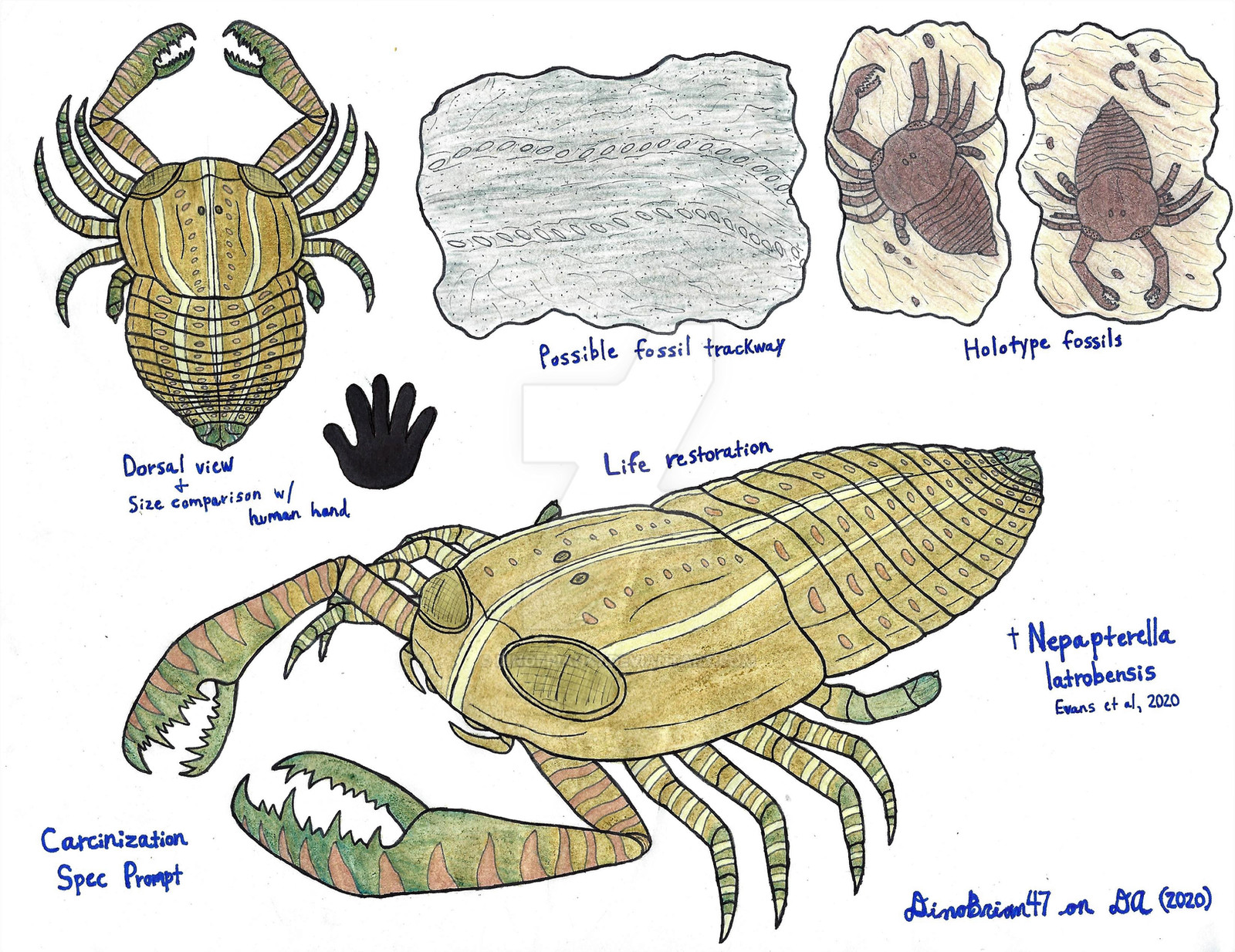HOME | DD
 DinoBrian47 — Carcinization Spec Prompt - Carcinized Eurypterid
DinoBrian47 — Carcinization Spec Prompt - Carcinized Eurypterid

#arthropod #australia #beach #challenge #claws #crab #crustacean #devonian #fossil #hand #lobster #prompt #scorpion #seascorpion #tracks #specevo #dinobrian47 #lediblock2 #carcinization #eurypterid #fossils #invertebrate #paleozoic #silhouette #sizecomparison #speculativeevolution
Published: 2020-11-12 20:12:03 +0000 UTC; Views: 14570; Favourites: 315; Downloads: 0
Redirect to original
Description
The basic crab body structure seems to be quite successful in the natural world, as indicated by the fact that various families of crustaceans have evolved a crab-esque morphology from predecessors that didn’t resemble crabs in the slightest. This intriguing form of convergent evolution is recognized as “carcinization”. Hermit crabs, king crabs, and porcelain crabs are among the most well-known and well-studied cases of this, but carcinization isn’t necessarily limited to just crustaceans; pseudoscorpions, crab spiders, and even giant water bugs vaguely resemble crabs in some aspects.
While there are several examples of carcinization among arthropods in today’s world, not many instances of it are known from the fossil record. Perhaps the only major example of this are the extinct cycloids, an order of crustaceans that bore a striking resemblance to crabs, which ironically enough were possibly driven to extinction by the evolution and diversification of true crabs during the Mesozoic. Nevertheless, more recent discoveries have shed more light on this unique type of convergent evolution, suggesting that some other families of arthropods evolved a crab-like morphology in Earth’s prehistory, long before the appearance of true crabs.
One example of this is Nepapterella latrobensis (“crab wing of Latrobe Valley”), a peculiar eurypterid that has been recently described from two nearly-complete fossils uncovered near Latrobe Valley in southeastern Victoria, Australia. Said fossils were unearthed from deposits dating back to the Famennian stage of the late Devonian, approximately 364 million years ago, in what is believed to have once been a saltwater or brackish-water environment. What sets Nepapterella apart from other eurypterids is its unique morphology, more closely resembling that of a crab than a typical eurypterid - with a bizarrly-shortened opisthosoma (abdomen), atrophied “swimming paddles”, four pairs of limbs (proportionately larger than those of its relatives) utilized more for walking than feeding, and large chelicerae reminiscent of a crab’s claws with well-developed denticles lining them. Based on phylogenetic analyses, Nepapterella is a derived member of the Pterygotidae (a family of eurypterids which includes the much larger and more famous Pterygotus and Jaekolopterus) and appears to be most closely-related to basal pterygotids such as Ciurcopterus. It was also a fairly-small eurypterid, with its broad prosoma measuring about 13 inches (33 centimeters) in diameter and the entire animal estimated at around 20 inches (50.8 centimeters) in length. Nepapterella is now believed to represent one of the earliest-kn]own cases of carcinization in the fossil record, having evolved its crab-like body plan millions of years before the evolution of the first cycloids.
Not much is known concerning the paleobiology and paleoecology of Nepapterella. However, a fossilized trackway possibly made by one discovered within close proximity of the Latrobe River might offer at least some insight into its lifestyle. Said trackway indicates that it was capable of limited terrestrial locomotion - similar to various crab species today - although it most likely wasn’t able to walk sideways like a crab due to the orientation of its legs. It likely embarked on terrestrial excursions to travel between bodies of water or to simply scavenge on washed-up carrion from the sea, and could survive out of water as long as its gills remained moist. Fragmentary fossils of crinoids, bivalves, gastropods, and ostracods have been found near the same locations as the two holotype Nepapterella specimens, suggesting that this crab-like eurypterid likely once inhabited a rich, shallow-water coastal environment, and some individuals possibly even resided in tide pools as well. What exactly Nepapterella fed upon in life is unknown; some paleontologists have theorized that unlike many other eurypterids, it may have been omnivorous not unlike various modern-day crabs, perhaps feeding on a mixed diet of aquatic vegetation, molluscs, small fish, carrion, and detritus. However, some other researchers have suggested that could’ve been exclusively carnivorous like other pterygotid eurypterids - a hypothesis based upon the fact that its eyes are rather similar to those of Pterygotus and Jaekolopterus, in that both of its eyes possessed a large amount of compound lenses and had a low interommatidial angle. This strongly implies that Nepapterella had a very high visual acuity in life akin to many active predatory arthropods today, though this could also imply that this eurypterid developed such superb vision as it developed its crab-like body plan, perhaps to aid it in its frequent travels across the shorelines of Devonian Australia.
And here you go! This is just a little something I whipped up for Lediblock2 's carcinization spec evo prompt for fun. I've been wanting to do some more speculative evolution stuff as of lately, and my friend's new monthly spec prompts feel like the perfect excuse for me to do so. I also wanted to tackle this to help motivate me into working on some major personal projects of mine again... so look out for those in the near future!
Related content
Comments: 26

👍: 0 ⏩: 0

👍: 0 ⏩: 0

👍: 0 ⏩: 0

👍: 0 ⏩: 0

👍: 1 ⏩: 0

👍: 1 ⏩: 1

👍: 2 ⏩: 1

👍: 0 ⏩: 0

👍: 0 ⏩: 0

👍: 0 ⏩: 1

👍: 0 ⏩: 0

👍: 1 ⏩: 0

👍: 0 ⏩: 1

👍: 2 ⏩: 2

👍: 0 ⏩: 0

👍: 0 ⏩: 1

👍: 1 ⏩: 0

👍: 0 ⏩: 0

👍: 0 ⏩: 1

👍: 1 ⏩: 1

👍: 0 ⏩: 0

👍: 0 ⏩: 1

👍: 0 ⏩: 1

👍: 0 ⏩: 0

👍: 1 ⏩: 1

👍: 0 ⏩: 0

























